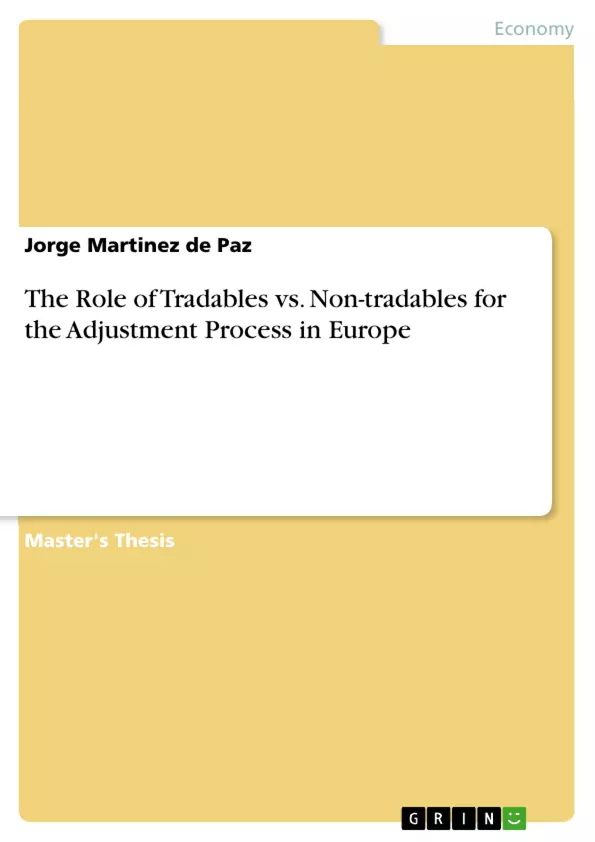This paper analyses macroeconomic imbalances within fixed exchange rate systems as the European Monetary Union. The leading question is explaining why during the years after the financial crisis of 2007, Institutions such as the European Commission and the IMF made policy recommendations aimed at shifting production resources from the non-tradable to the tradable sector; especially in countries with large current account imbalances and low competitiveness.
Inferring that not accomplishing such a reallocation of production resources will yield a major ‘pain of adjustment’, the paper investigates the role of the non-tradable sector size in the European adjustment process. The mentioned ‘pain of adjustment’ plays a central role and is understood as the time and/or the contraction required for reaching a certain level of external balance in terms of social costs, most notably unemployment.
The conclusions are based on a graphical modification of Krugman and Obstfeld's (2006) model conceived for explaining the rigidities of the Bretton Woods system of fixed exchange rates and suggest that deficit countries with underemployment attempting to reach external and internal balance can reduce the ‘pain of adjustment’ by fostering the tradable sector to the detriment of an oversized, uncompetitive and low productive non-tradable sector.
Inhaltsverzeichnis (Table of Contents)
- Introduction
- I. Fixed exchange rates systems prior to EMU and resemblances
- 1. The Gold Standard
- 2. The new Gold Standard and the Great Depression
- 3. The Bretton Woods System
- II. The generation of European current account imbalances
- 1. Diverging competitiveness through price and wage growth differentials
- 2. Diverging non-price competitiveness
- 3. The role of tradables vs. non-tradables for the generation of imbalances
- About non-tradables
- The role of non-tradables for current account imbalances
- III. The size of the non-tradable sector and the current account balance
- 1. Tradability according to actual trade
- 2. Geographical concentration as a tradability indicator
- 3. Identification of countries relevant for the analysis
- IV. The adjustment process in the euro area
- 1. Policy alternatives for deficit countries
- 2. Short-run adjustment and the importance of the external sector
- 3. Long-run adjustment and the importance of market flexibility
- Flexible labor markets
- Flexible product markets
- 4. The role of non-tradables for the adjustment process, a graphical analysis
- Outline of ultimate results and critical appraisal
Zielsetzung und Themenschwerpunkte (Objectives and Key Themes)
This paper aims to analyze the role of tradable versus non-tradable goods in the adjustment process of the euro area, specifically focusing on countries with large current account imbalances. The paper investigates the relationship between the size of the non-tradable sector and the current account balance, examining how imbalances arise and how they can be addressed. It draws upon the recommendations of the European Commission and the International Monetary Fund regarding structural reforms, specifically emphasizing the need to shift resources from the non-tradable sector to the tradable sector.
- The impact of fixed exchange rate systems on economic imbalances
- The role of tradable and non-tradable sectors in generating current account imbalances
- The relationship between the size of the non-tradable sector and the current account balance
- The adjustment process in the euro area, particularly in deficit countries
- Policy alternatives for addressing imbalances, including the importance of labor and product market flexibility
Zusammenfassung der Kapitel (Chapter Summaries)
- Introduction: This chapter introduces the context of the paper, highlighting the economic challenges facing the euro area and the need for structural reforms. It emphasizes the importance of shifting resources from the non-tradable sector to the tradable sector in countries with large current account imbalances.
- I. Fixed exchange rates systems prior to EMU and resemblances: This section reviews historical fixed exchange rate systems, including the Gold Standard, the new Gold Standard, and the Bretton Woods System. It analyzes the similarities and differences between these systems and their implications for economic stability and imbalances.
- II. The generation of European current account imbalances: This chapter explores the causes of current account imbalances in the euro area, focusing on diverging competitiveness through price and wage growth differentials, non-price competitiveness, and the role of tradable versus non-tradable goods. It explains how the composition of production and consumption in different countries contributes to imbalances.
- III. The size of the non-tradable sector and the current account balance: This section examines the relationship between the size of the non-tradable sector and the current account balance. It analyzes different indicators of tradability, including actual trade data and geographical concentration. It also identifies countries relevant for the analysis based on their size and the severity of their imbalances.
- IV. The adjustment process in the euro area: This chapter discusses the adjustment process in the euro area, considering policy alternatives available to deficit countries. It explores the importance of the external sector in short-run adjustment and market flexibility in long-run adjustment. The role of non-tradable goods in the adjustment process is analyzed through a graphical framework.
Schlüsselwörter (Keywords)
The core concepts explored in this paper include fixed exchange rate systems, current account imbalances, tradable and non-tradable goods, euro area adjustment, structural reforms, labor market flexibility, product market flexibility, and economic stability. The analysis focuses on the relationship between the size of the non-tradable sector and the current account balance, examining the implications for economic policy and stability in the euro area.
- Quote paper
- Jorge Martinez de Paz (Author), 2012, The Role of Tradables vs. Non-tradables for the Adjustment Process in Europe, Munich, GRIN Verlag, https://www.grin.com/document/318228



